Yamaha NHB32-C, ACU16-C User Manual
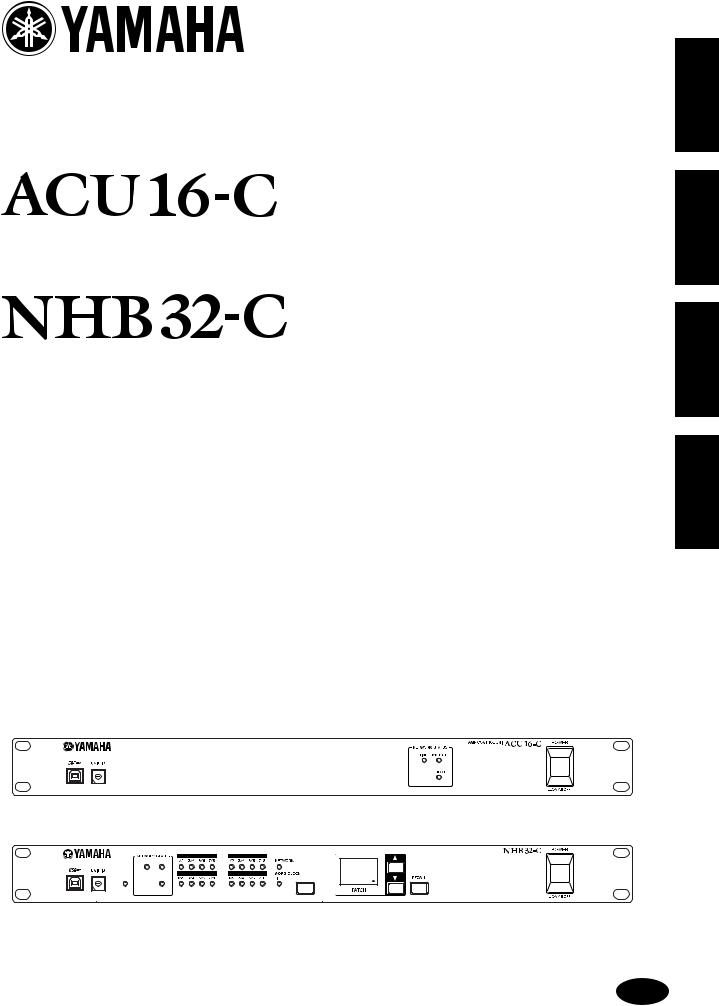
AMP CONTROL UNIT
NETWORK HUB and BRIDGE
Owner’s Manual Mode d’emploi Bedienungsanleitung
Manual de instrucciones
NETWORK HUB AND BRIDGE
LINK |
CONDUCT |
88 |
LOCK |
ERROR |
ESPAÑOL DEUTSCH FRANÇAIS ENGLISH
M

ACU16-C/NHB32-C
Owner’s Manual Addendum
Please make the following changes and additions to the ACU16-C/NHB32-C owner’s manual. Some of these are due to the ACU16-C/NHB32-C system software upgrade, while others are corrections and supplementary explanations.
Changes due to the software upgrade
Support for CobraNet “Low Latency” (system software v1.10)
In conjunction with the upgrade to system software V1.10, the latency setting that had been fixed at 5.33 ms can now be selected from three choices (5.33 ms/2.67 ms/1.33 ms). This allows even lower-latency distribution of audio signals. In addition, you can now make connections at the desired latency to digital mixers such as the PM5D or digital mixing engines such as the DME64N/24N via the Yamaha “MY16-C” card.
Changing the latency can be done in conjunction with NetworkAmp Manager V1.1.0E. For the procedure, refer to the NetworkAmp Manager owner’s manual (PDF format).
The latency and audio bit depth settings will determine the limits on the number of channels that can be distributed in one bundle, and the number of bundles that can be distributed.
• NHB32-C
|
|
20-bit |
|
24-bit |
Latency |
|
|
|
|
Channels per |
Maximum number of bundles |
Channels per |
Maximum number of bundles |
|
|
bundle |
(total of input and output) |
bundle |
(total of input and output) |
|
|
|
|
|
5.33ms |
8 |
8 |
7 |
8 |
|
|
|
|
|
2.67ms |
8 |
8 |
8 |
8 |
|
|
|
|
|
1.33ms |
8 |
4 |
8 |
4 |
|
|
|
|
|
• ACU16-C
Latency |
Maximum number of |
|
bundles (input only) |
||
|
||
|
|
|
5.33ms |
4 |
|
|
|
|
2.67ms |
4 |
|
|
|
|
1.33ms |
4 |
|
|
|
If two or more different latencies exist in a CobraNet network, it may become impossible for the various devices to communicate correctly. You must make sure that all CobraNet devices in a single network have the same latency setting.
Additions and corrections
Cable Length & Switching Hubs
The maximum length of a cable used in a 100Base-T Ethernet network is 100 m (a maximum of 2 km for a multimode optical fiber cable), but depending on the type of cable used and on the performance of the switching hub, there are cases in which this length cannot be guaranteed. Three or four switching hubs can be connected, but this also will depend on the performance of the switching hub.
“System Requirements (NetworkAmp Manager)” (page 10)
The following items have been added to the operating requirements for NetworkAmp Manager.
•If your computer has HyperThreading Technology, you must disable it when connecting via USB.
•This software cannot be used on a computer that has multiple CPUs (e.g., Intel’s Xeon processor or AMD’s Opteron processor).
•This software cannot be used on a computer that has a dual core CPU (e.g., Intel’s Pentium-D processor or AMD’s Athlon64 x2 processor).
•This software cannot be used on a computer running Windows XP x64 Edition.
– 2 –
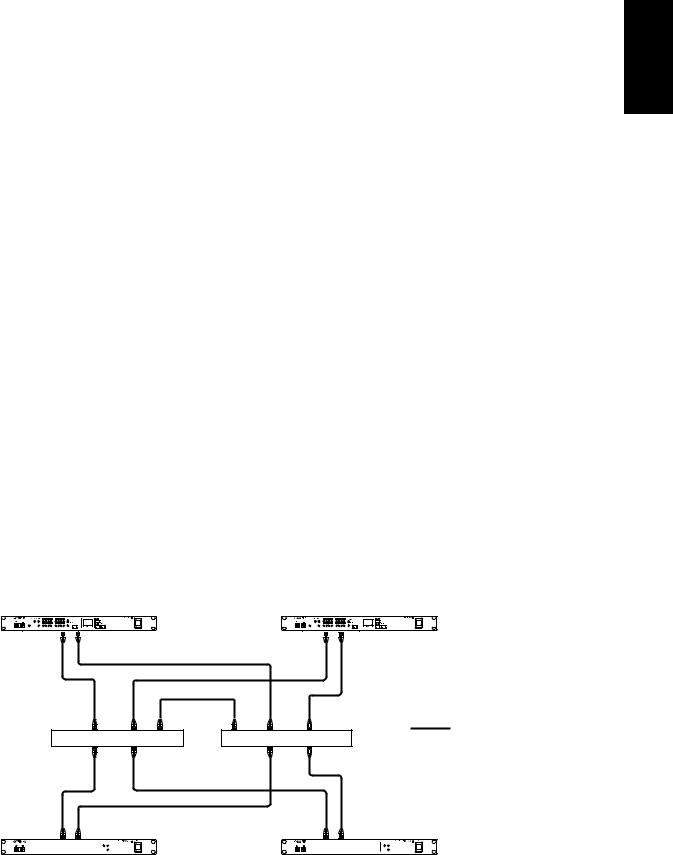
“Installing Acrobat Reader” (page 12)
Incorrect—To view the Network Amp Manager Owner’s Manual, you’ll need to install the Adobe Acrobat Reader software, which is included on the CD-ROM. If you already have this software installed, skip this section.
Correct—To view the NetworkAmp Manager Owner’s Manual (PDF format), Adobe Reader software (free of charge) must be installed. If you don’t have Adobe Reader, please download it from the Adobe Corporation’s website. http://www.adobe.com
“PRIMARY & SECONDARY CobraNet ports” (page 22)
Incorrect—Primary and secondary can be used to build redundancy into systems. Under normal conditions, the ACU16-C uses the PRIMARY port. However, if communication via that port fails, it will automatically switch to the SECONDARY port and operation will continue uninterrupted.
Correct—Primary and secondary can be used to build redundancy into systems. Under normal conditions, the ACU16- C uses the PRIMARY port. However, if system problems such as port malfunction or broken cable occur in the PRIMARY port, it will automatically switch to the SECONDARY port. The audio signal will be momentarily interrupted, but the duration of the interruption will depend on the performance and settings of the hub, and on the structure of the system.
“Introduction” (page 25)
Incorrect—Up to eight NHB32-Cs can be used on a single CobraNet network, providing bridging between 512 CobraNet audio channels and 512 AES/EBU format inputs and outputs.
Correct—Up to eight NHB32-Cs can be used on a single CobraNet network, providing bridging a maximum (total inputs and outputs) of 256 channels of CobraNet audio and AES/EBU audio.
“CobraNet Primary & Secondary” (page 35)
Incorrect—In the first example, if a primary connection fails, the system automatically switches to secondary and operation continues uninterrupted. However, if the switching hub fails, the entire system stops working. In the second example, individual switching hubs are used for primary and secondary, so even if switching hub A fails, operation continues on secondary via switching hub B.
Correct—In the first example, if a primary connection fails, the system automatically switches to secondary. However if the switching hub fails, the entire system stops working. In the second example, individual switching hubs are used for primary and secondary, so even if switching hub A fails, operation continues on secondary via switching hub B.
Be aware that with either connection, the time required in order to switch between primary and secondary will depend on the performance and settings of the hub.
“CobraNet Primary & Secondary, Ex. 2” (page 35)
In consideration of a case in which the primary connection fails, connect switching hub A and switching hub B.
NHB32-C |
|
|
|
NHB32-C |
|||||||
|
|
|
|
|
|
|
|
|
|
|
|
ENGLISH
Primary CobraNet
Ethernet switching hub A |
Ethernet switching hub B |
 Secondary CobraNet
Secondary CobraNet
ACU16-C |
ACU16-C |
– 3 –
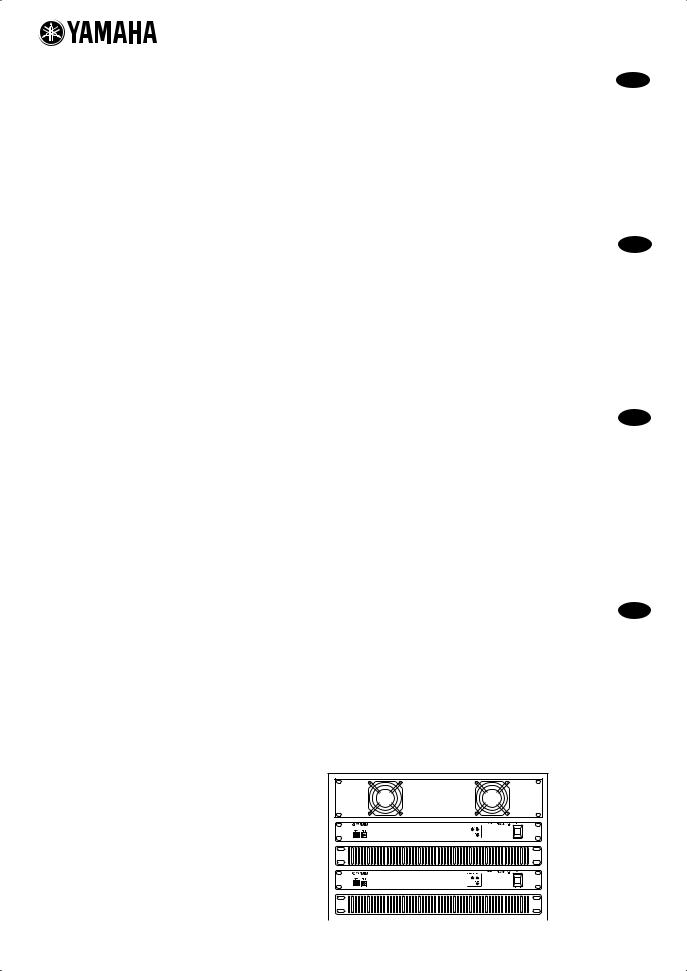




 /
/ 




Notes on rack-mounting the unit |
E |
If you install the ACU16-C/NHB32-C along with another ACU16-C/NHB32-C or other device in a rack that is not well ventilated, the temperature inside the rack may rise due to the heat generated from the devices and the devices may be unable to perform properly. When you rack-mount the unit, be sure to keep a gap of 1U (4.5cm) above and below the unit for better ventilation. Also, install the ventilation panels in these gaps or remove the partition panels.
If the temperature inside the rack is expected to be 40°C or higher (in this case, the room temperature is generally about 30°C or higher), install the fan kit on the top shelf of the rack, and install the ventilation panels between devices or remove the partition panels. The fan kit must generate a maximum wind of 1.6m3/min or higher and a maximum static pressure of 5mmH2O or higher.
Anmerkungen zum Rackeinbau des Geräts |
D |
|
Wenn Sie den ACU16-C/NHB32-C gemeinsam mit einem anderen ACU16-C/NHB32-C oder einem Gerät mit mangelhafter Lüftung in ein Rack einbauen, könnte die Temperatur im Innern des Racks rapide ansteigen und Ausfälle der vorhandenen Geräte verursachen. Lassen Sie über und unter Geräten in einem Rack jeweils 1HE (4,5cm) frei, um eine ausreichende Luftzirkulation zu gewährleisten. In diesen Öffnungen müssen Lüftungsblenden angebracht werden. Außerdem sind eventuell vorhandene Trennplatten zu entfernen.
Wenn die Temperatur im Innern des Racks die 40°C-Marke zu übersteigen droht (was der Fall ist, wenn die Raumtemperatur mindestens 30°C beträgt), müssen Sie ganz oben im Rack eine Lüftereinheit und zwischen den Geräten Lüftungsblenden einbauen. Trennplatten zwischen diesen Partien müssen entfernt werden. Die Lüftereinheit muss einen Luftstrom von mindestens 1,6m3/min und einen statischen Druck von 5mmH2O oder mehr erzeugen.
Remarques concernant l’installation de l’unité dans un rack |
F |
Si vous installez l’ACU16-C/NHB32-C dans le même rack qu’un deuxième ACU16-C/NHB32-C ou tout autre dispositif avec une ventilation autonome plutôt limitée, la température au sein du rack pourrait très vite monter à des valeurs qui empêchent les unités de fonctionner correctement. De ce fait, pour le montage en rack, il convient de laisser un espace d’1U (4,5cm) au-dessus et en dessous de tels dispositifs pour assurer une bonne circulation d’air frais. De plus, il faut couvrir les ouvertures ainsi laissées avec des panneaux de ventilation. Retirez toute cloison éventuellement présente entre deux unités.
Si la température au sein du rack risque de monter au-delà de 40°C (auquel cas la température ambiante s’élève à 30°C ou plus), installez un kit de ventilation en haut du rack et des panneaux de ventilation entre les unités. Retirez en outre les cloisons qui les séparent. Le kit de ventilation doit générer un flux d’air supérieur à 1,6m3/min et une pression statique de 5mmH2O ou plus.
Notas acerca de la instalación en rack de la unidad |
S |
Si instala el ACU16-C/NHB32-C junto con otro ACU16-C/ NHB32-C u otro dispositivo en un armario rack que no esté correctamente ventilado, la temperatura en el interior del armario puede elevarse debido al calor generado por los propios dispositivos y afectar al correcto funcionamiento de los mismos. Cuando instale la unidad en rack, asegúrese de dejar una separación de 1U (4.5cm) por encima y por debajo de la unidad con el fin de conseguir una correcta ventilación. Además, instale los paneles de ventilación en estas separaciones o elimine los paneles de partición.
Si se calcula que la temperatura en el interior del rack sea de 40°C o más (en este caso, cuando la temperatura de la habitación es de 30°C o superior), instale el kit de ventilación en la parte superior del armario rack e instale los paneles de ventilación entre los dispositivos o elimine los paneles de división. El kit de ventilación debe generar un caudal mínimo de 1.6m3/min o superior con una presión estática mínima de 5 mm H2O o superior.
fan kit/Lüftereinheit/ Kit de ventilation/Kit de ventilación
ACU16-C/NHB32-C
ventilation panel/Lüftungsblenden/ Panneau de ventilation/Panel de ventilación
ACU16-C/NHB32-C
ventilation panel/Lüftungsblenden/ Panneau de ventilation/Panel de ventilación
M.D.G., Pro Audio & Digital Musical Instrument Division, Yamaha Corporation
© 2003 Yamaha Corporation
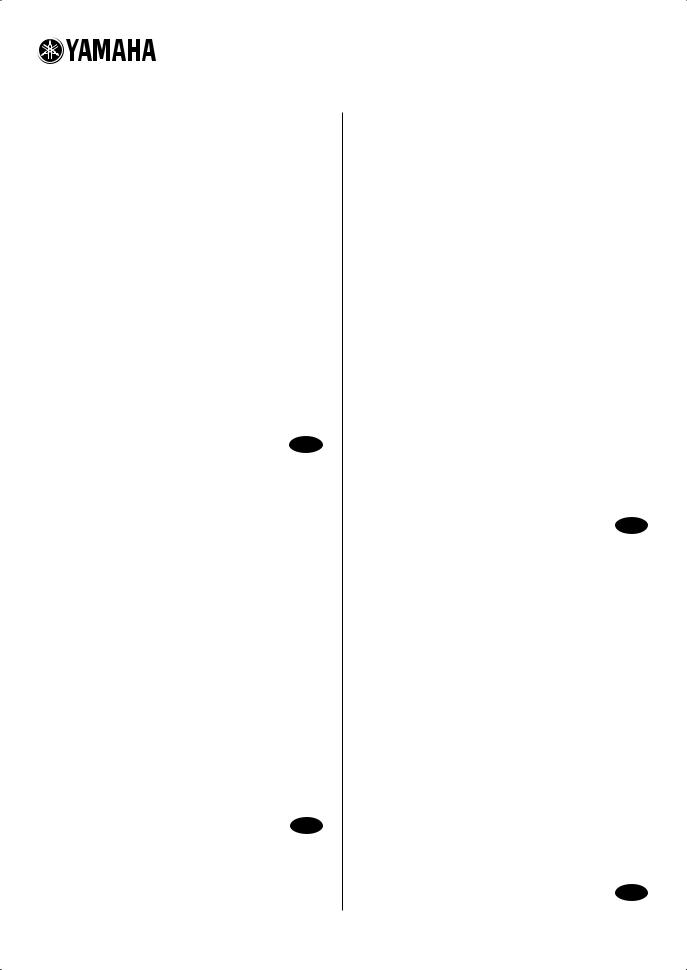




 /
/ 




Important Note for PC-N Series Power Amplifier Users
When you are using the ACU16-C connected to a PC9500N or PC4800N power amplifier, the NetworkAmp Manager's meter may not display the correct value, depending on your power amplifier. Please check your power amplifier for the following items to find out whether the problem has been fixed on your amplifier:
Locate the product serial number label on the packing container or on the rear panel of the power amplifier.
•If the first two alphabetical letters in the serial number are IL, IM, IN, IO, IP, IX, IY, IZ, or JH, the problem may not have been fixed on the amplifier. Otherwise, you can assume that the problem has been fixed on your amplifier.
•On units that have a serial number that begins with any of the letter combinations described above, if there is a green round sticker adjacent to the serial number label, the problem has been fixed on the unit.
If the problem has not been fixed on your power amplifier, contact your Yamaha dealer.
E
Wichtiger Hinweis für den Einsatz von Endstufen der PC-N-Serie
Wenn Sie den ACU16-C an eine Endstufe des Typs PC9500N oder PC4800N anschließen, zeigen die Meter von NetworkAmp Manager eventuell nicht den richtigen Wert an. Wenn das bei Ihnen der Fall ist, können Sie folgendermaßen ermitteln, ob das Problem der Endstufe behoben werden muss:
Bringen Sie die Seriennummer Ihrer Endstufe in Erfahrung. Diese finden Sie auf dem Lieferkarton und dem rückseitigen Typenschild.
•Wenn die ersten beiden Buchstaben der Seriennummer „IL”, „IM”, „IN”, „IO”, „IP”, „IX”, „IY”, „IZ” oder „JH” lauten, bedarf die Endstufe eventuell noch einer Aktualisierung. Andernfalls können Sie davon ausgehen, dass das Problem bereits behoben wurde.
•Auf Geräten, deren Seriennummer mit den oben erwähnten Buchstaben beginnt und bei denen das Problem bereits behoben wurde, befindet sich neben dem Typenschild ein runder grüner Aufkleber.
Fehlt dieser Aufkleber auf Ihrer Endstufe, so wenden Sie sich bitte an Ihren Yamaha-Händler.
D
Remarque importante à l’attention des utilisateurs d’un amplificateur de puissance de la série PC-N
Quand l’ACU16-C est branché à un amplificateur de puissance PC9500N ou PC4800N, il se peut (selon l’ampli de puissance) que l’affichage de niveau de NetworkAmp Manager n’indique pas la valeur correcte. Contrôlez alors le numéro de série de votre amplificateur comme suit pour vérifier si ce problème doit être corrigé ou non:
Vérifiez le numéro de série de l’amplificateur sur l’emballage ou le panneau arrière de l’appareil.
•Si les deux premières lettres du numéro de série correspondent à “IL”,“IM”,“IN”,“IO”,“IP”,“IX”,“IY”,“IZ” ou “JH”, le problème n’a peut-être pas été corrigé sur l’amplificateur. Si les lettres initiales du numéro de série diffèrent des caractères ci-dessus, vous pouvez partir du principe que le problème a été corrigé sur votre amplificateur.
•Certains amplificateurs dont le numéro de série commence par une paire de lettres mentionnée ci-dessus pourraient comporter une vignette ronde et verte collée à côté de l’étiquette du numéro de série. La présence de cette vignette signifie que le problème a été corrigé sur l’appareil en question.
Si le problème n’a pas été corrigé sur votre amplificateur de puissance, contactez votre revendeur Yamaha.
F
Nota importante para los usuarios de los amplificadores de la serie PC-N
Si utiliza el ACU16-C conectado a un amplificador PC9500N o PC4800N, el indicador NetworkAmp del Manager puede que no visualice el valor correcto, dependiendo de su amplificador.
Compruebe los siguientes elementos en su amplificador para saber si el problema se ha solucionado:
Localice la etiqueta del número de serie del producto en el embalaje o en el panel posterior del amplificador.
•Si las dos primeras letras del número de serie son “IL”, “IM”, “IN”, “IO”, “IP”, “IX”, “IY”, “IZ” o “JH”, es posible que el problema no se haya solucionado en el amplificador. De lo contrario, puede asumir que el problema se ha solucionado en el amplificador.
•En las unidades con números de serie que empiecen por cualquier serie de letras mencionada, si observa un punto verde al lado de la etiqueta del número de serie, el problema se ha solucionado en la unidad.
Si el problema persiste en el amplificador, contacte con su distribuidor Yamaha.
S
M.D.G., Pro Audio & Digital Musical Instrument Division, Yamaha Corporation © 2003 Yamaha Corporation

FCC INFORMATION (U.S.A.)
1.IMPORTANT NOTICE: DO NOT MODIFY THIS UNIT! This product, when installed as indicated in the instructions contained in this manual, meets FCC requirements. Modifications not expressly approved by Yamaha may void your authority, granted by the FCC, to use the product.
2.IMPORTANT: When connecting this product to accessories and/or another product use only high quality shielded cables. Cable/s supplied with this product MUST be used. Follow all installation instructions. Failure to follow instructions could void your FCC authorization to use this product in the USA.
3.NOTE: This product has been tested and found to comply with the requirements listed in FCC Regulations, Part 15 for Class “B” digital devices. Compliance with these requirements provides a reasonable level of assurance that your use of this product in a residential environment will not result in harmful interference with other electronic devices. This equipment generates/uses radio frequencies and, if not installed and used according to the instructions found in the users manual, may cause interference harmful to the operation of other electronic devices. Compliance with FCC regulations does not guarantee that interference will not occur in all installations. If this product is found to be the source of interference, which can be determined by turning the unit “OFF” and “ON”, please try to eliminate the problem by using one of the following measures: Relocate either this product or the device that is being affected by the interference. Utilize power outlets that are on different branch (circuit breaker or fuse) circuits or install AC line filter/s. In the case of radio or TV interference, relocate/reorient the antenna. If the antenna lead-in is 300 ohm ribbon lead, change the lead-in to coaxial type cable. If these corrective measures do not produce satisfactory results, please contact the local retailer authorized to distribute this type of product. If you can not locate the appropriate retailer, please contact Yamaha Corporation of America, Electronic Service Division, 6600 Orangethorpe Ave, Buena Park, CA 90620
The above statements apply ONLY to those products distributed by Yamaha Corporation of America or its subsidiaries.
WARNING: THIS APPARATUS MUST BE EARTHED
IMPORTANT
THE WIRES IN THIS MAINS LEAD ARE COLOURED IN
ACCORDANCE WITH THE FOLLOWING CODE:
GREEN-AND-YELLOW : EARTH
BLUE : NEUTRAL
BROWN : LIVE
As the colours of the wires in the mains lead of this apparatus may not correspond with the coloured markings identifying the terminals in your plug, proceed as follows:
The wire which is coloured GREEN and YELLOW must be connected to the terminal in the plug which is marked by the letter E or by the safety earth symbol  or coloured GREEN and YELLOW.
or coloured GREEN and YELLOW.
The wire which is coloured BLUE must be connected to the terminal which is marked with the letter N or coloured BLACK.
The wire which is coloured BROWN must be connected to the terminal which is marked with the letter L or coloured RED.
*This applies only to products distributed by YAMAHA KEMBLE MUSIC (U.K.) LTD.
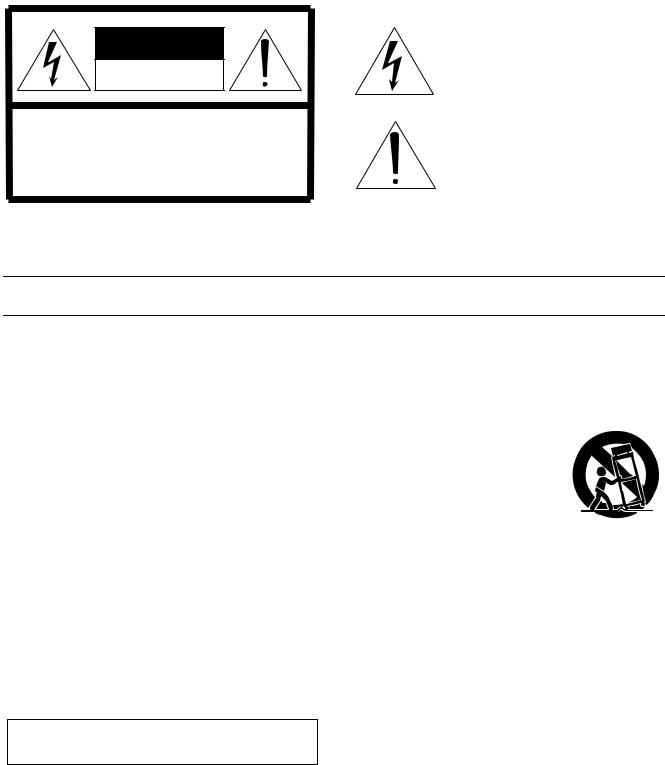
CAUTION
RISK OF ELECTRIC SHOCK
DO NOT OPEN
CAUTION: TO REDUCE THE RISK OF ELECTRIC SHOCK, DO NOT REMOVE COVER (OR BACK). NO USER-SERVICEABLE PARTS INSIDE. REFER SERVICING TO QUALIFIED SERVICE PERSONNEL.
The above warning is located on the top of the unit.
Explanation of Graphical Symbols
The lightning flash with arrowhead symbol within an equilateral triangle is intended to alert the user to the presence of uninsulated “dangerous voltage” within the product’s enclosure that may be of sufficient magnitude to constitute a risk of electric shock to persons.
The exclamation point within an equilateral triangle is intended to alert the user to the presence of important operating and maintenance (servicing) instructions in the literature accompanying the product.
IMPORTANT SAFETY INSTRUCTIONS
1Read these instructions.
2Keep these instructions.
3Heed all warnings.
4Follow all instructions.
5Do not use this apparatus near water.
6Clean only with dry cloth.
7Do not block any ventilation openings. Install in accordance with the manufacturer’s instructions.
8Do not install near any heat sources such as radiators, heat registers, stoves, or other apparatus (including amplifiers) that produce heat.
9Do not defeat the safety purpose of the polarized or grounding-type plug. A polarized plug has two blades with one wider than the other. A grounding type plug has two blades and a third grounding prong. The wide blade or the third prong are provided for your safety. If the provided plug does not fit into your outlet, consult an electrician for replacement of the obsolete outlet.
WARNING
TO REDUCE THE RISK OF FIRE OR ELECTRIC SHOCK,
DO NOT EXPOSE THIS APPARATUS TO RAIN OR MOISTURE.
10Protect the power cord from being walked on or pinched particularly at plugs, convenience receptacles, and the point where they exit from the apparatus.
11Only use attachments/accessories specified by the manufacturer.
12Use only with the cart, stand, tripod, bracket, or table spec-
ified by the manufacturer, or sold with the apparatus. When a cart is used, use caution when moving the cart/ apparatus combination to avoid injury from tip-over.
13Unplug this apparatus during lightning storms or when unused for long periods of time.
14Refer all servicing to qualified service personnel. Servicing is required when the apparatus has been damaged in any way, such as powersupply cord or plug is damaged, liquid has been spilled or objects have fallen into the apparatus, the apparatus has been exposed to rain or moisture, does not operate normally, or has been dropped.

4
Software Licensing Agreement
The following is a legal agreement between you, the end user, and Yamaha Corporation (“Yamaha”). The enclosed Yamaha software program is licensed by Yamaha to the original purchaser for use only on the terms set forth herein. Please read this licensing agreement with care. Opening this package indicates that you accept all terms outlined herein. If you do not agree to the terms, return this package unopened to Yamaha for a full refund.
GRANT OF LICENSE AND COPYRIGHT: Yamaha grants you, the original purchaser, the right to use one copy of the enclosed software program and data (“SOFTWARE”) on a single-user computer system. You may not use it on more than one computer or computer terminal. The SOFTWARE is owned by Yamaha and is protected by Japanese copyright laws and all applicable international treaty provisions.You are entitled to claim ownership of the media in which the SOFTWARE is included. Therefore, you must treat the SOFTWARE like any other copyrighted materials.
RESTRICTIONS: The SOFTWARE program is copyrighted. You may not engage in reverse engineering or reproduction of the SOFTWARE by other conceivable methods.You may not reproduce, modify, change, rent, lease, resell, or distribute the SOFTWARE in whole or in part, or create derivative works from the SOFTWARE. You may not transmit or network the SOFTWARE with other computers. You may transfer ownership of the SOFTWARE and the accompanying written materials on a permanent basis provided that you retain no copies and the recipient agrees to the terms of the licensing agreement.
TERMINATION: The licensing condition of the software program becomes effective on the day that you receive the SOFTWARE. If any one of the copyright laws or clauses of the licensing conditions is violated, the licensing agreement shall be terminated automatically without notice from Yamaha. In this case, you must destroy the licensed SOFTWARE and its copies immediately.
PRODUCT WARRANTY: Yamaha warrants to the original purchaser that if the SOFTWARE, when used in normal conditions, will not perform the functions described in the manual provided by Yamaha, the sole remedy will be that Yamaha will replace any media which proves defective in materials or workmanship on an exchange basis without charge. Except as expressly set forth above, the SOFTWARE is provided “as is,” and no other warranties, either expressed or implied, are made with respect to this software, including, without limitation the implied warranties of merchantability and fitness for a particular purpose.
LIMITED LIABILITY: Your sole remedies and Yamaha’s entire liability are as set forth above. In no event will Yamaha be liable to you or any other person for any damages, including without limitation any incidental or consequential damages, expenses, lost profits, lost savings or other damages arising out of the use or inability to use such SOFTWARE even if Yamaha or an authorized dealer has been advised of the possibility of such damages, or for any claim by any other party.
GENERAL: This license agreement shall be interpreted according to and governed by Japanese laws.
ACU16-C & NHB32-C Owner’s Manual

5
Precautions
Warnings
Installation
•Connect this unit’s power cord only to an AC outlet of the type stated in this Owner’s Manual or as marked on the unit. Failure to do so is a fire and electrical shock hazard.
•Do not allow water to enter this unit or allow the unit to become wet. Fire or electrical shock may result.
•Do not place heavy objects, including this unit, on top of the power cord. A damaged power cord is a fire and electrical shock hazard. In particular, be careful not to place heavy objects on a power cord covered by a carpet.
•Do not place a container with liquid or small metal objects on top of this unit. Liquid or metal objects inside this unit are a fire and electrical shock hazard.
Operation
•Do not scratch, bend, twist, pull, or heat the power cord. A damaged power cord is a fire and electrical shock hazard.
•Do not remove the unit’s cover. You could receive an electrical shock. If you think internal inspection, maintenance, or repair is necessary, contact your dealer.
•Do not modify the unit. Doing so is a fire and electrical shock hazard.
•If lightning begins to occur, turn off the power switch of the unit as soon as possible, and unplug the power cable plug from the electrical outlet.
•If there is a possibility of lightning, do not touch the power cable plug if it is still connected. Doing so may be an electrical shock hazard.
•Use only the included power cord with this unit. Using other types may be a fire and electrical shock hazard.
In case an abnormality occurs during operation
•If the power cord is damaged (i.e., cut or a bare wire is exposed), ask your dealer for a replacement. Using the unit with a damaged power cord is a fire and electrical shock hazard.
•If you notice any abnormality, such as smoke, odor, or noise, or if a foreign object or liquid gets inside the unit, turn it off immediately. Disconnect the power cord. Consult your dealer for repair. Using the unit in this condition is a fire and electrical shock hazard.
•Should this unit be dropped or the cabinet be damaged, turn the power switch off, remove the power plug from the AC outlet, and contact your dealer. If you continue using the unit without heeding this instruction, fire or electrical shock may result.
ENGLISH
ACU16-C & NHB32-C Owner’s Manual

6
Cautions
Installation
•Keep this unit away from the following locations:
—Locations exposed to oil splashes or steam, such as near cooking stoves, humidifiers, etc.
—Unstable surfaces, such as a wobbly table or slope.
—Locations exposed to excessive heat, such as inside a car with all the windows closed, or places that receive direct sunlight.
—Locations subject to excessive humidity or dust accumulation.
•Hold the power cord plug when disconnecting it from an AC outlet. Never pull the cord. A damaged power cord is a potential fire and electrical shock hazard.
•Do not touch the power plug with wet hands. Doing so is a potential electrical shock hazard.
•This unit has ventilation holes to prevent the internal temperature from rising too high. Do not block them. Blocked ventilation holes are a fire hazard. In particular, do not operate the unit while it’s on its side, is upside down, or while it’s covered with a cloth or dust sheet.
•When installing the unit in a rack, you must use the rack-mounting screw holes at the rear in addition to those on the front panel.
•When rack-mounting or stacking several units, always leave at least 1U (i.e., about 4.5 cm) of free space above and below the unit for normal ventilation. If the airflow is restricted, the unit may overheat, which could cause a fire.
•To relocate the unit, turn the power switch off, remove the power plug from the AC outlet, and remove all connecting cables. Damaged cables may cause fire or electrical shock.
•This unit is equipped with a dedicated ground connection to prevent electrical shock. Before connecting the power plug to an AC outlet, be sure to ground the unit. If the power cord has a three-pin plug, it will provide sufficient grounding so long as the AC outlet is grounded correctly.
Operation
•If you know you will not use this unit for a long period of time, such as when going on vacation, remove the power plug from the AC outlet. Leaving it connected is a potential fire hazard.
Maintenance
•To prevent electrical shock when cleaning the unit, remove the power plug from the AC outlet.
ACU16-C & NHB32-C Owner’s Manual

7
Important Information
Operating Notes
•The performance of components with moving contacts, such switches, rotary controls, faders, and connectors, deteriorates over time. The rate of deterioration depends on the operating environment and is unavoidable. Consult your dealer about replacing defective components.
•Using a mobile telephone near this unit may induce noise. If noise occurs, use the telephone away from the unit.
•The digital circuits of this unit may induce a slight noise into nearby radios and TVs. If noise occurs, relocate the affected equipment.
•When connecting D-sub cables, be sure to tighten the screws on both sides of the connector securely. To disconnect the cable, loosen the screws completely, then remove the cable by holding the connector part. Do not remove the plug by pulling the cable while the screws are still attached. Otherwise, the connector may be damaged, leading to malfunction.
•When you change the wordclock settings on any device in your digital audio system, some devices may output noise, so turn down your power amps beforehand, otherwise your speakers may be damaged.
Special Notices
•The software and this owner’s manual are the exclusive copyrights of Yamaha Corporation.
•Use of the software and this manual is governed by the license agreement which the purchaser fully agrees to upon breaking the seal of the software packaging. (Please read carefully the Software Licensing Agreement at the beginning of this manual before installing the application.)
•Copying of the software or reproduction of this manual in whole or in part by any means is expressly forbidden without the written consent of the manufacturer.
•Yamaha makes no representations or warranties with regard to the use of the software and documentation and cannot be held responsible for the results of the use of this manual and the software.
•This disc is a CD-ROM. Do not attempt to play the disc on an audio CD player. Doing so may result in irreparable damage to your audio CD player.
•Copying of the commercially available music sequence data and/or digital audio files is strictly prohibited except for your personal use.
•The screen displays as illustrated in this owner’s manual are for instructional purposes, and may appear somewhat different from the screens which appear on your computer.
•Future upgrades of application and system software and any changes in specifications and functions will be announced separately.
ENGLISH
ACU16-C & NHB32-C Owner’s Manual

8
Trademarks
Adobe, Acrobat, and Reader are registered trademarks of Adobe Systems Incorporated. CobraNet and Peak Audio are trademarks of Cirrus Logic, Inc. Ethernet is a trademark of Xerox Corporation. Intel and Pentium are registered trademarks of Intel Corporation. Microsoft and Windows are registered trademarks of Microsoft Corporation, Inc. Yamaha is a trademark of Yamaha Corporation. All other trademarks are the property of their respective holders and are hereby acknowledged.
Yamaha Web Site
Further information about this unit, related products, and other Yamaha professional audio equipment is available on the Yamaha Professional Audio Web site at: <http://www.yamaha.co.jp/product/proaudio/homeenglish/>.
Package Contents
ACU16-C
•ACU16-C Amp Control Unit
•CD-ROM (NetworkAmp Manager, PDF manual, MIDI drivers)
•Power cord and retaining clamp
•USB cable (for connection to PC running NetworkAmp Manager)
•3-way Euro-block connectors x16
•This manual
NHB32-C
•NHB32-C Network Hub and Bridge
•CD-ROM (NetworkAmp Manager, PDF manual, MIDI drivers)
•Power cord and retaining clamp
•USB cable (for connection to PC running NetworkAmp Manager)
•This manual
About this Owner’s Manual
This Owner’s Manual consists of three main sections:
•NetworkAmp Manager Installation
•ACU16-C Amp Control Unit
•NHB32-C Network Hub and Bridge
All the information you need in order to install NetworkAmp Manager, and to operate the ACU16-C and NHB32-C is contained in this manual. Although the ACU16-C and NHB32-C can be used standalone, first they need to be configured using NetworkAmp Manager. The PDF format Network Amp Manager Owner’s Manual, which contains a glossary of NetworkAmp Manager, ACU16-C, and NHB32-C related terms, is on the supplied CD-ROM.
A wealth of information about CobraNet, with sections especially for designers and installers, is available on the Peak Audio Web site at <http://www.peakaudio.com>. If you are designing a CobraNet network, we strongly recommend that you visit this Web site and study the information available in order to fully understand the CobraNet technology. Peak Audio also provide a list of Ethernet devices that have been tested with CobraNet, including switching hubs and media converters.
ACU16-C & NHB32-C Owner’s Manual

9
Contents
1 NetworkAmp Manager Installation . . . . . . . . . . . |
10 |
Introduction . . . . . . . . . . . . . . . . . . . . . . . . . . . . . . . . . . . . . . . . . . . . . . . . . . . . . . . . 10
CD-ROM Contents . . . . . . . . . . . . . . . . . . . . . . . . . . . . . . . . . . . . . . . . . . . . . . . . . . 10
System Requirements . . . . . . . . . . . . . . . . . . . . . . . . . . . . . . . . . . . . . . . . . . . . . . . . 10
ACU16-C/NHB32-C Hookup . . . . . . . . . . . . . . . . . . . . . . . . . . . . . . . . . . . . . . . . . 11
Installing Acrobat Reader . . . . . . . . . . . . . . . . . . . . . . . . . . . . . . . . . . . . . . . . . . . . . 12
Installing the USB MIDI Driver . . . . . . . . . . . . . . . . . . . . . . . . . . . . . . . . . . . . . . . . 12
Installing the Yamaha CBX Driver . . . . . . . . . . . . . . . . . . . . . . . . . . . . . . . . . . . . . 18
Installing NetworkAmp Manager . . . . . . . . . . . . . . . . . . . . . . . . . . . . . . . . . . . . . . 18
Starting NetworkAmp Manager . . . . . . . . . . . . . . . . . . . . . . . . . . . . . . . . . . . . . . . . 18
Installation Troubleshooting . . . . . . . . . . . . . . . . . . . . . . . . . . . . . . . . . . . . . . . . . . 18
2 ACU16-C Amp Control Unit . . . . . . . . . . . . . . . . . |
20 |
Introduction . . . . . . . . . . . . . . . . . . . . . . . . . . . . . . . . . . . . . . . . . . . . . . . . . . . . . . . . 20
Features . . . . . . . . . . . . . . . . . . . . . . . . . . . . . . . . . . . . . . . . . . . . . . . . . . . . . . . . . . . 20
Front Panel . . . . . . . . . . . . . . . . . . . . . . . . . . . . . . . . . . . . . . . . . . . . . . . . . . . . . . . . . 21
Rear Panel . . . . . . . . . . . . . . . . . . . . . . . . . . . . . . . . . . . . . . . . . . . . . . . . . . . . . . . . . 22
Specifications . . . . . . . . . . . . . . . . . . . . . . . . . . . . . . . . . . . . . . . . . . . . . . . . . . . . . . . 23
Dimensions . . . . . . . . . . . . . . . . . . . . . . . . . . . . . . . . . . . . . . . . . . . . . . . . . . . . . . . . 24
3 NHB32-C Network Hub & Bridge . . . . . . . . . . . . . 25
Introduction . . . . . . . . . . . . . . . . . . . . . . . . . . . . . . . . . . . . . . . . . . . . . . . . . . . . . . . . 25
Features . . . . . . . . . . . . . . . . . . . . . . . . . . . . . . . . . . . . . . . . . . . . . . . . . . . . . . . . . . . 25
Front Panel . . . . . . . . . . . . . . . . . . . . . . . . . . . . . . . . . . . . . . . . . . . . . . . . . . . . . . . . . 26
Rear Panel . . . . . . . . . . . . . . . . . . . . . . . . . . . . . . . . . . . . . . . . . . . . . . . . . . . . . . . . . 28
Specifications . . . . . . . . . . . . . . . . . . . . . . . . . . . . . . . . . . . . . . . . . . . . . . . . . . . . . . . 30
Dimensions . . . . . . . . . . . . . . . . . . . . . . . . . . . . . . . . . . . . . . . . . . . . . . . . . . . . . . . . 31
4 System Examples . . . . . . . . . . . . . . . . . . . . . . . . . . 32
ACU16-C Power Amp Control System . . . . . . . . . . . . . . . . . . . . . . . . . . . . . . . . . . 32 ACU16-C/NHB32-C CobraNet Audio Distribution System . . . . . . . . . . . . . . . . 33 MIDI Over CobraNet . . . . . . . . . . . . . . . . . . . . . . . . . . . . . . . . . . . . . . . . . . . . . . . . 34 AD824 Control Over CobraNet . . . . . . . . . . . . . . . . . . . . . . . . . . . . . . . . . . . . . . . . 34 CobraNet Primary & Secondary . . . . . . . . . . . . . . . . . . . . . . . . . . . . . . . . . . . . . . . 35
Troubleshooting . . . . . . . . . . . . . . . . . . . . . . . . . . . . . |
36 |
System Errors . . . . . . . . . . . . . . . . . . . . . . . . . . . . . . . . . . . . . . . . . . . . . . . . . . . . . . . 37
Appendix . . . . . . . . . . . . . . . . . . . . . . . . . . . . . . . . . . . 38
Connector Wiring Details . . . . . . . . . . . . . . . . . . . . . . . . . . . . . . . . . . . . . . . . . . . . . 38
ENGLISH
ACU16-C & NHB32-C Owner’s Manual

10 NetworkAmp Manager Installation
1 NetworkAmp Manager Installation
Introduction
This chapter explains how to install NetworkAmp Manager and the necessary drivers. For information on how to use NetworkAmp Manager, refer to the Network Amp Manager Owner’s Manual, which is included on the CD-ROM in PDF format and can be opened directly from NetworkAmp Manager’s Help menu.
CD-ROM Contents
Folder |
Software |
Description |
|
|
|
|
|
Acroread\English |
Acrobat Reader1, 2 |
Adobe Acrobat Reader software for view- |
|
ing the PDF format manuals. |
|||
|
|
||
NetworkAmp Manager |
NetworkAmp Manager1 |
NetworkAmp Manager program and |
|
PDF format manual. |
|||
|
|
||
|
|
|
|
Mididrv_ |
Yamaha CBX Driver |
Yamaha serial driver. Necessary if you are |
|
connecting to a serial port on your PC. |
|||
|
|
||
|
|
|
|
USBdrv_ |
Yamaha USB MIDI Driver |
|
|
(Windows 98, Me) |
Yamaha USB driver. Necessary if you are |
||
|
|||
USBdrv2k_ |
Yamaha USB MIDI Driver |
connecting to a USB port on your PC. |
|
(Windows 2000, XP) |
|
||
|
|
||
|
|
|
1.For details on using this software, refer to the PDF manual after installation.
2.This software is not supported by Yamaha.
System Requirements
The system requirements of your operating system may be different to those listed here.
NetworkAmp Manager
Computer |
PC with a 450 MHz or faster Intel Pentium or Celeron family processor |
|
|
OS |
Windows 98, 98SE, Me, 2000, XP Home Edition, XP Professional |
|
|
Memory |
64 MB or more (128 MB or more recommended) |
|
|
Hard Disk |
100 MB or more of free space |
|
|
Display |
1024 x 768 pixels, 32,000 colors or higher |
|
|
Yamaha USB MIDI Driver
Computer |
PC with a 166 MHz or faster Intel Pentium or Celeron family processor and USB port |
|
|
OS |
Windows 98, 98SE, Me, 2000, XP Home Edition, XP Professional |
|
|
Memory |
32 MB or more |
|
|
Hard Disk |
2 MB or more of free space |
|
|
Yamaha CBX Driver
OS |
Windows 95, 98, 98SE, Me, NT4.0, 2000, XP Home Edition, XP Professional |
|
|
System requirements for software not listed here can be found on the CD-ROM.
ACU16-C & NHB32-C Owner’s Manual
